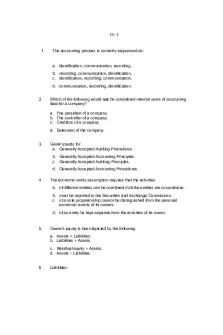Test 2, questions PDF

| Title | Test 2, questions |
|---|---|
| Course | Anatomy and Physiology I |
| Institution | Humber College |
| Pages | 2 |
| File Size | 153.2 KB |
| File Type | |
| Total Downloads | 77 |
| Total Views | 137 |
Summary
Download Test 2, questions PDF
Description
BIOL1414 Term Test 2 Short Answer Questions Please answer the following using complete sentences. 1.Describe the process of intramembranous bone formation. (5 marks) formation of bone directly from mesenchymal cells Ossification center: mesenchymal cells osteoprogenitor cells then osteoblasts Calcification: osteoblasts surround themselves with matrix, osteocytes; matrix hardens matrix develops into trabeculae; mesenchyme condenses at surface; red bone marrow formed Condensed mesenchyme → periosteum; superficial layers of spongy bone are replaced by compact bone 2. Describe what happens in each step of the skeletal muscle contraction cycle (including any changes to ATP, myosin, etc). Assume that calcium has already bound to the troponin-tropomyosin complex, exposing the myosin binding sites on actin. Please limit your answer to the contraction cycle only. (5 marks)
3. Contrast myelination in the CNS and the PNS (including what cells are involved, differences in the neurolemma, etc). (5 marks) oligodendrocyte form myelin sheath around multiple CNS axons • broad, flat processes of oligodendrocytes wrap about CNS axons, but cell bodies do not surround them • no neurolemma, so little regrowth occurs following damage Schwann cell surround PNS axons • form myelin sheath around axons in PNS • separated by nodes of Ranvier • myelin sheaths form around PNS axons during fetal development • cytoplasm and nucleus of Schwann cells form neurolemma • myelin sheath lies deep to neurilemma
4. Describe the process of synaptic transmission (including any ion movements, receptor binding, etc). (5 marks) - action potential arrives - Ca++ enters axon terminal - vesicles migrate to presynaptic membrane, neurotransmitter is released and diffuses across synaptic clef - neurotransmitter binds to ligand-gated receptor sites on postsynaptic neuron - 5. sodium enters postsynaptic cell - postsynaptic membrane depolarized to threshold - action potential occurs in postsynaptic neuron - neurotransmitter is split from receptors by an enzyme and are: o reabsorbed (re-uptake) inactivated by an enzyme (degradation) diffuse away
5. For each of the lettered regions (A, B, and C) in the diagram, provide: • the name of the phase • the state of the ion gates (open or closed) • the movement of any ions (type of ion and direction of movement) (5 marks)...
Similar Free PDFs

Test 2 January, questions
- 123 Pages

Chapter 2 Test Questions
- 31 Pages

Test 2, questions
- 2 Pages

Questions for Test No. 2
- 2 Pages

Test 2 October 2019, questions
- 7 Pages

Mod 1 & 2 - Test Questions
- 10 Pages

Psych Test 2 Practice Questions
- 5 Pages

Test 2 Oxygenation I Questions
- 3 Pages

TEST 2 - ECO Tutorial Questions
- 24 Pages

Test, questions
- 6 Pages

Test Questions
- 3 Pages

Test, questions
- 4 Pages

Test 2 - Test 2
- 5 Pages
Popular Institutions
- Tinajero National High School - Annex
- Politeknik Caltex Riau
- Yokohama City University
- SGT University
- University of Al-Qadisiyah
- Divine Word College of Vigan
- Techniek College Rotterdam
- Universidade de Santiago
- Universiti Teknologi MARA Cawangan Johor Kampus Pasir Gudang
- Poltekkes Kemenkes Yogyakarta
- Baguio City National High School
- Colegio san marcos
- preparatoria uno
- Centro de Bachillerato Tecnológico Industrial y de Servicios No. 107
- Dalian Maritime University
- Quang Trung Secondary School
- Colegio Tecnológico en Informática
- Corporación Regional de Educación Superior
- Grupo CEDVA
- Dar Al Uloom University
- Centro de Estudios Preuniversitarios de la Universidad Nacional de Ingeniería
- 上智大学
- Aakash International School, Nuna Majara
- San Felipe Neri Catholic School
- Kang Chiao International School - New Taipei City
- Misamis Occidental National High School
- Institución Educativa Escuela Normal Juan Ladrilleros
- Kolehiyo ng Pantukan
- Batanes State College
- Instituto Continental
- Sekolah Menengah Kejuruan Kesehatan Kaltara (Tarakan)
- Colegio de La Inmaculada Concepcion - Cebu


